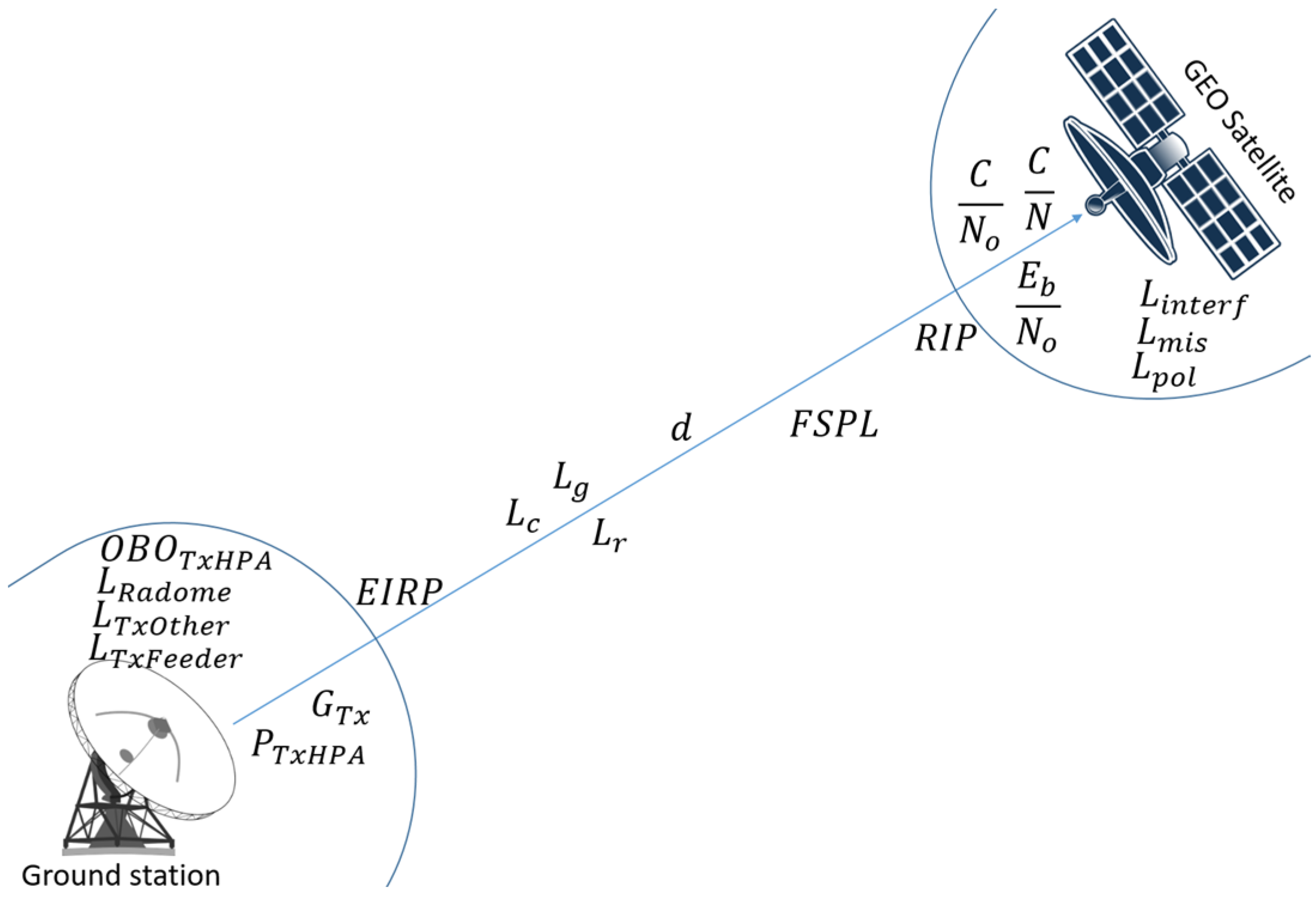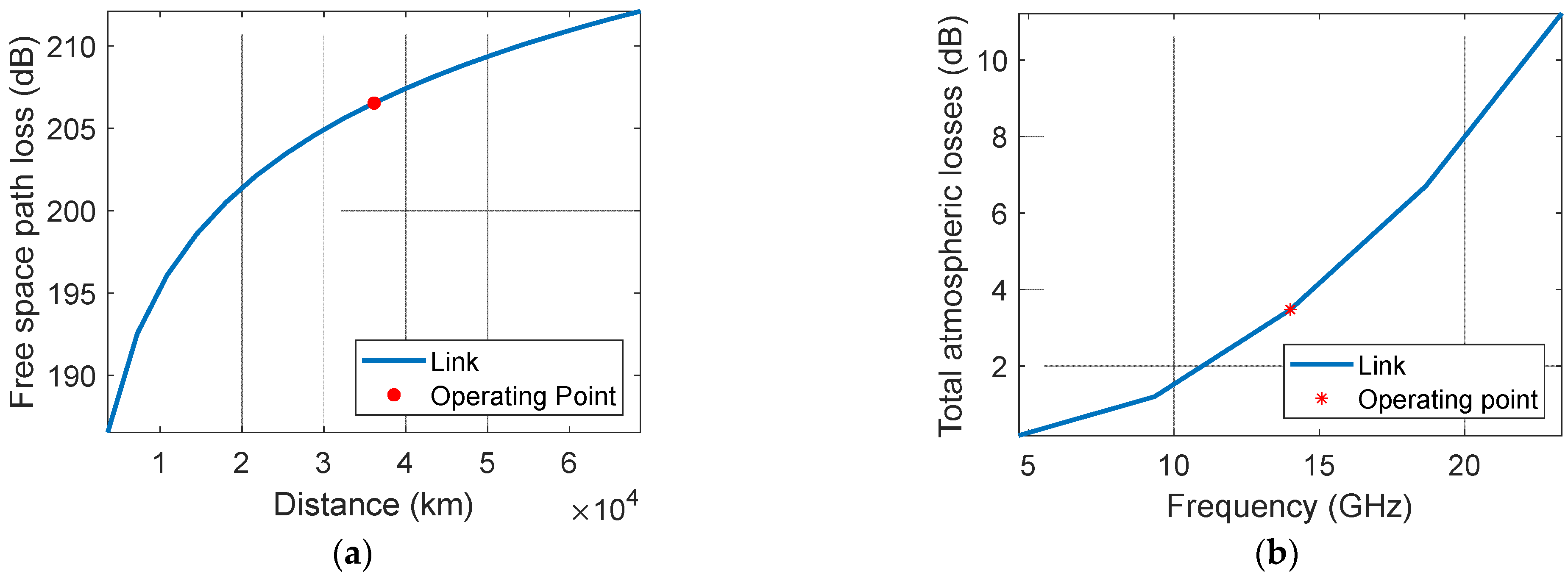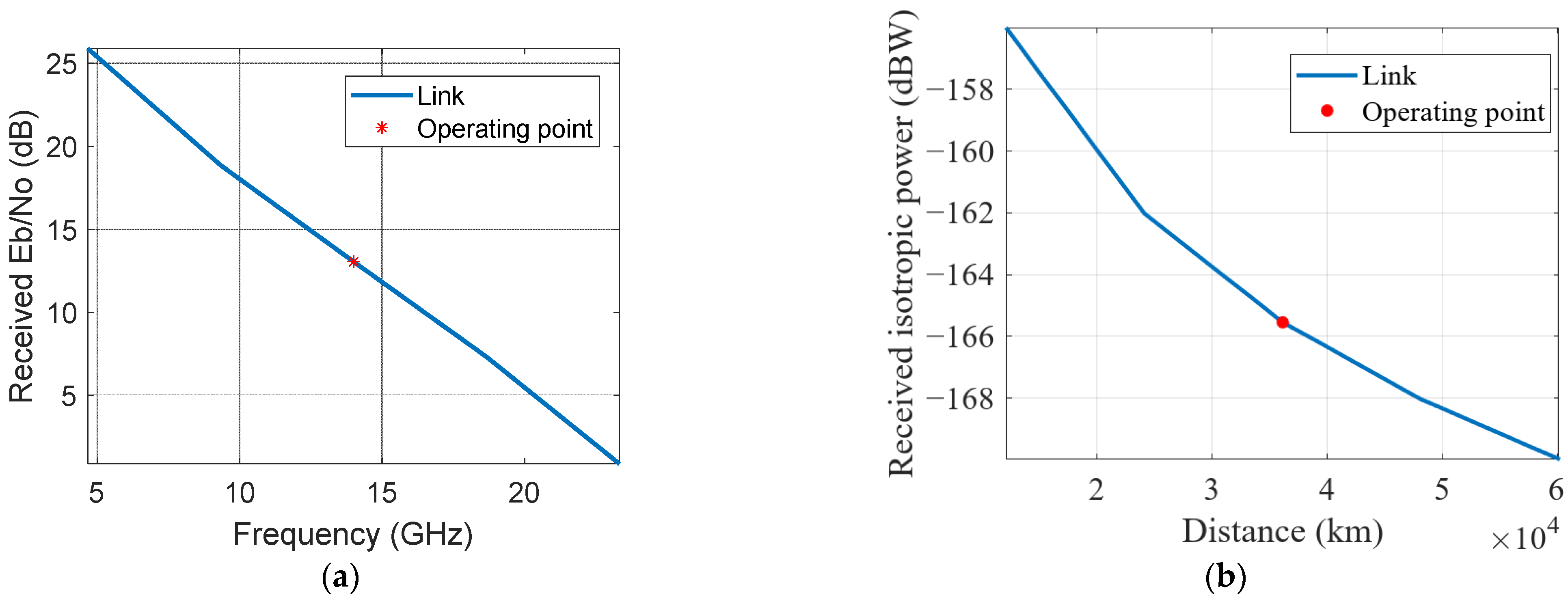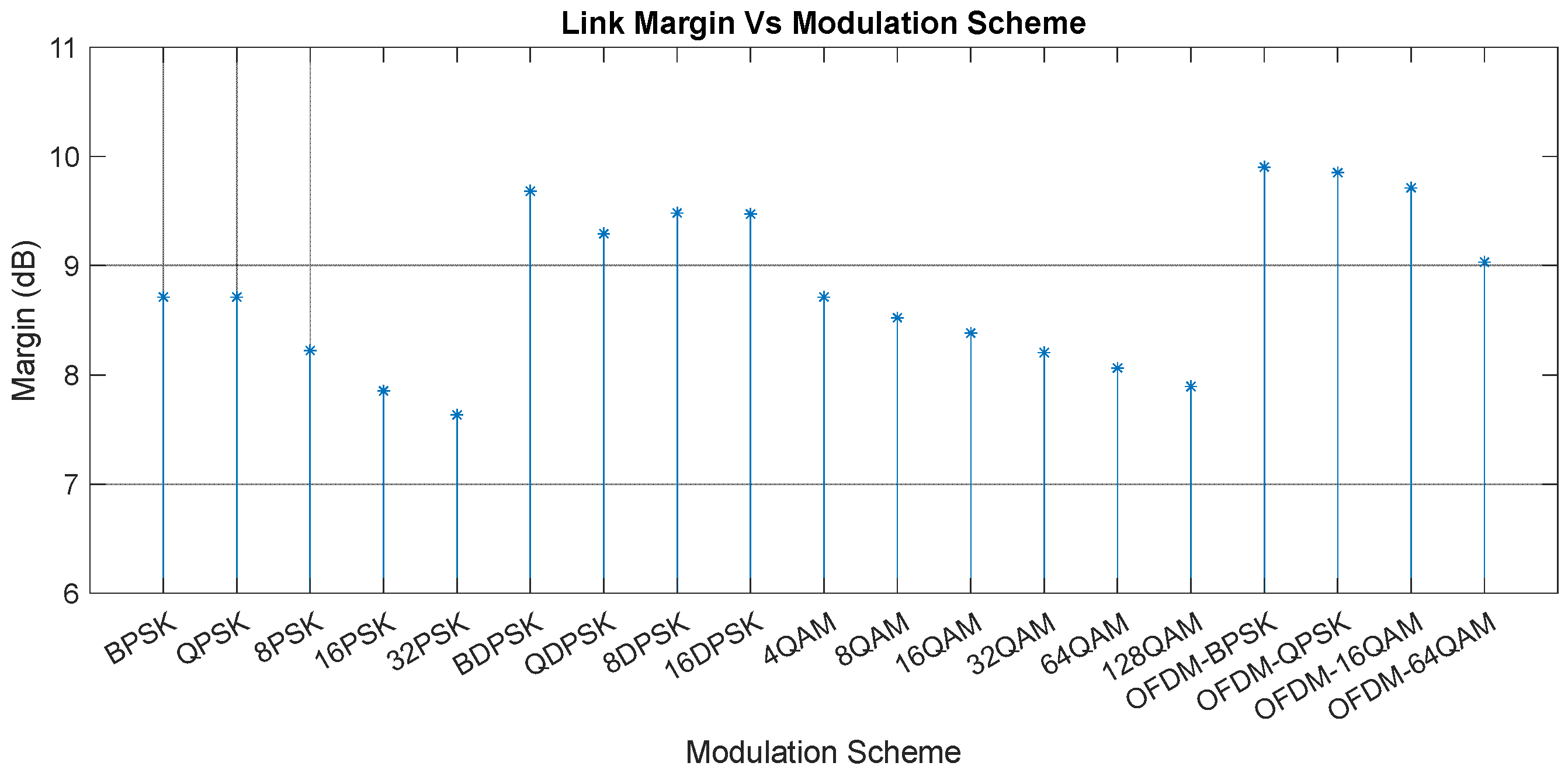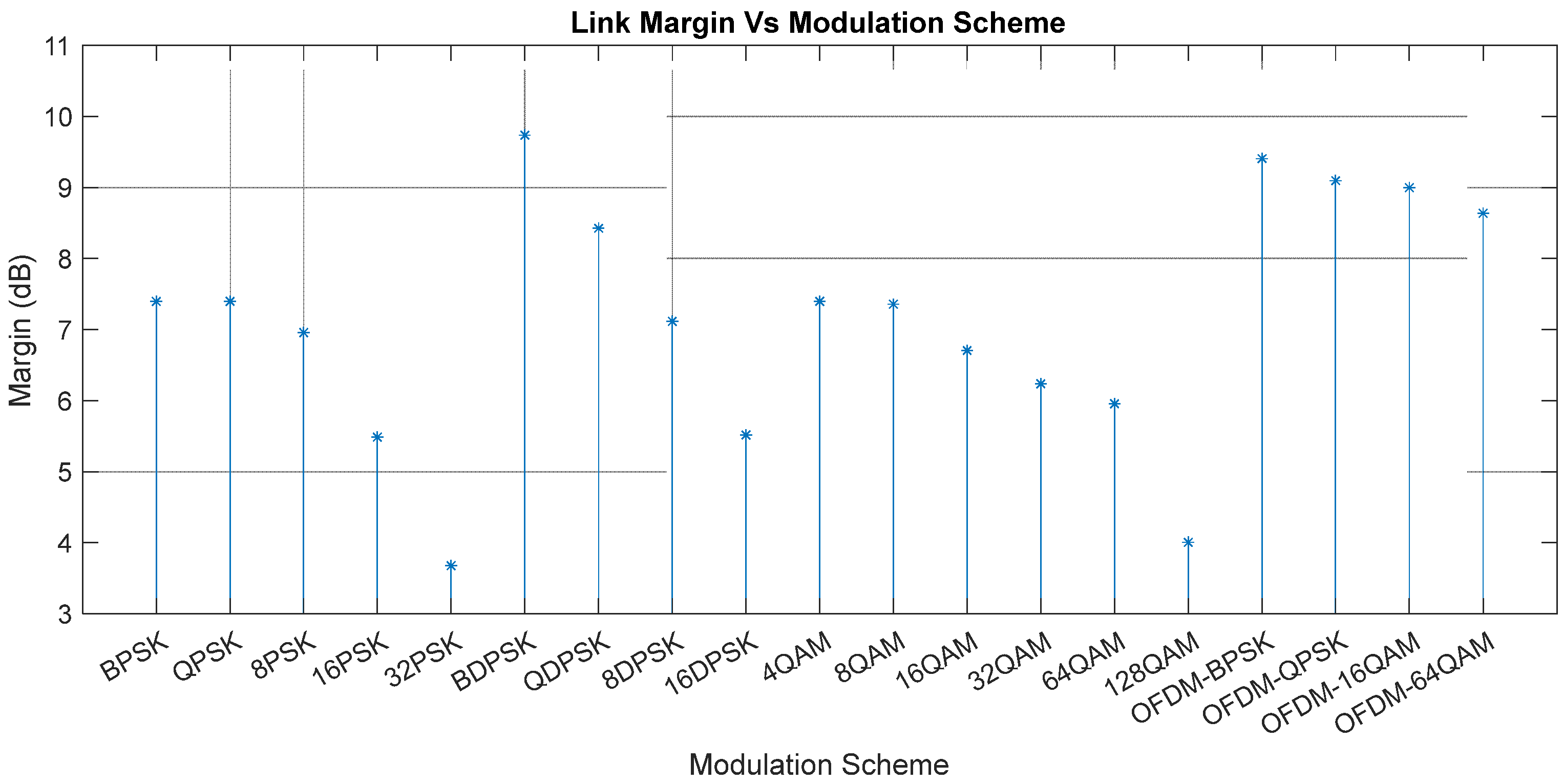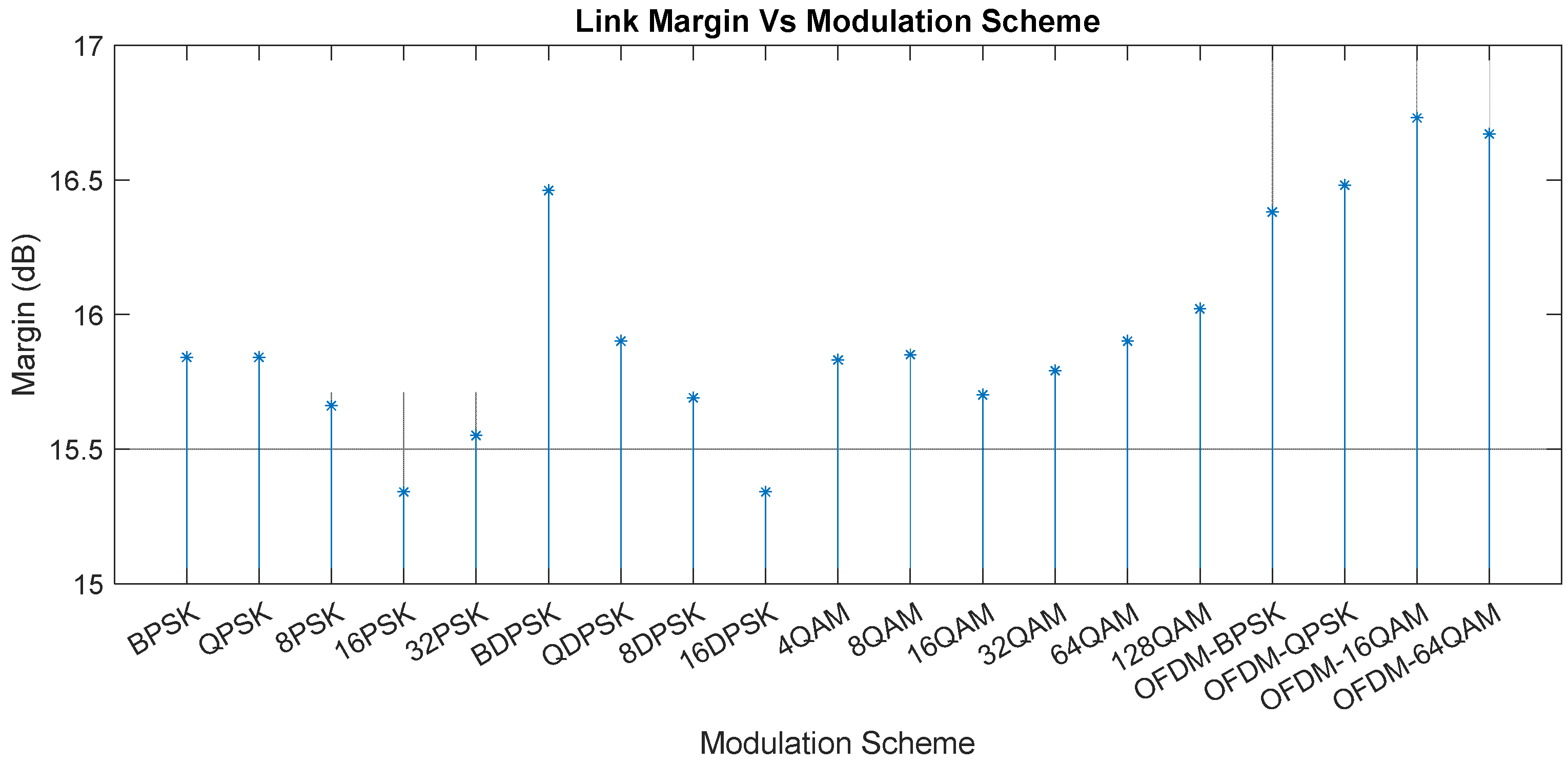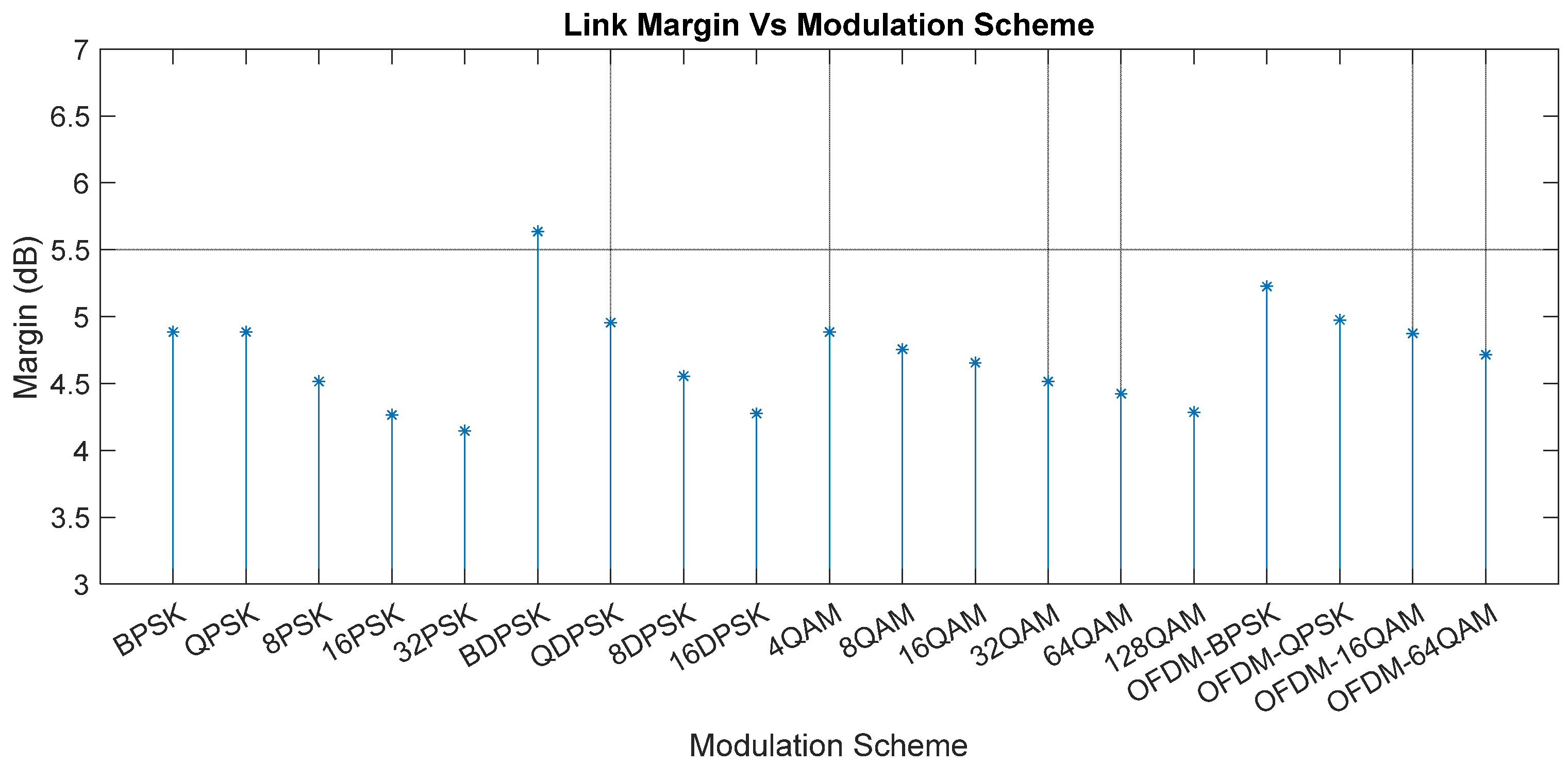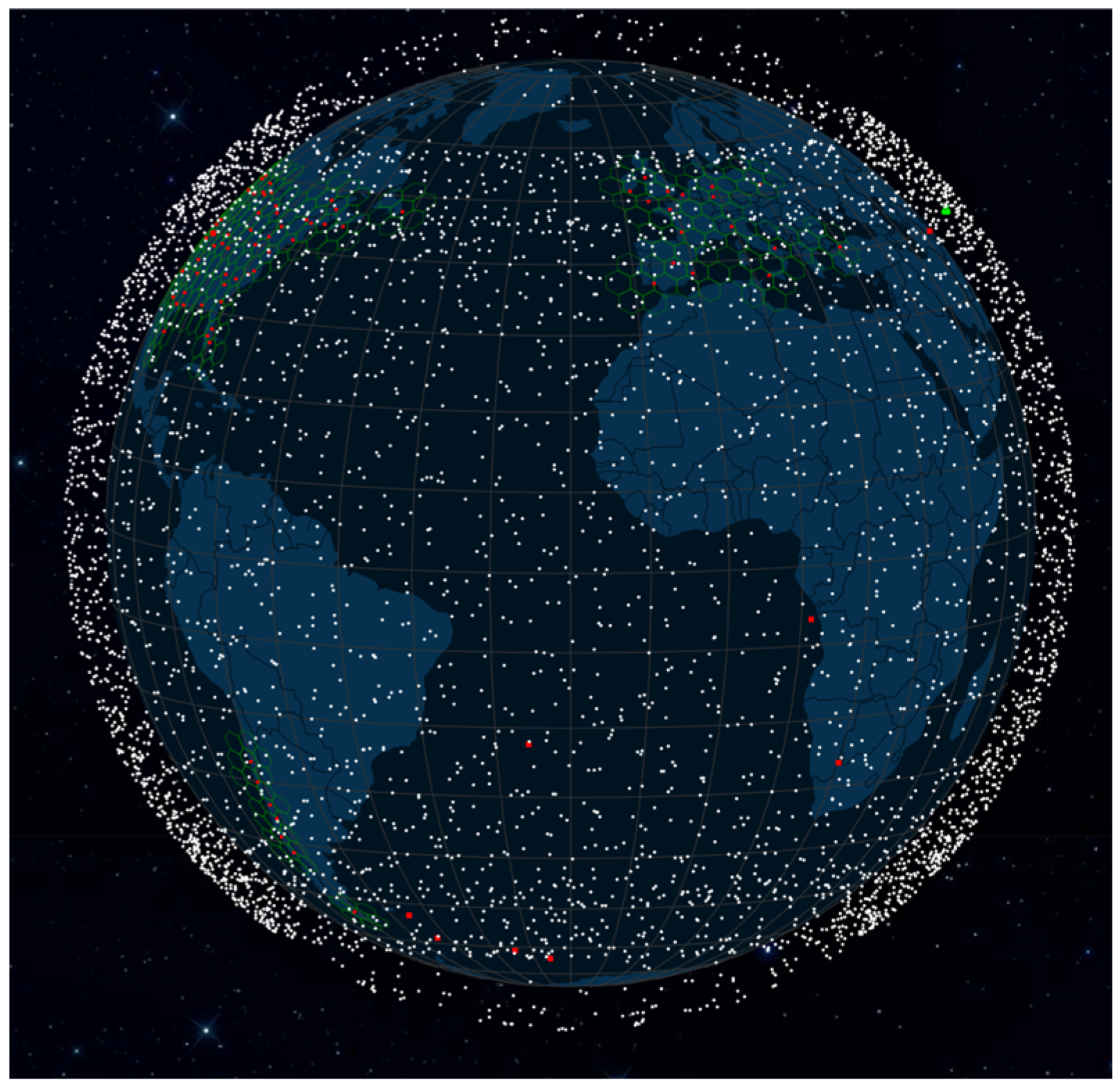1. Introduction
Satellite communications are part of the global telecommunications infrastructure, offering crucial services such as remote area connectivity, disaster response, and vital communication channels [
1,
2]. Satellites enable extensive coverage due to their strategic placement, proving indispensable for transmitting signals across vast distances. Specifically, geostationary orbit (GEO) satellites are essential in this framework because their fixed position relative to the Earth makes them perfect for applications requiring constant and consistent coverage over broad areas, such as TV broadcasting, meteorological services, and emergency communication systems [
3].
The increasing trend towards the development and deployment of multi-orbital systems consists of a combination of satellite placement on Low Earth Orbit (LEO), Medium Earth Orbit (MEO), and GEO to achieve global connectivity, low latency, and operational redundancies. These systems combine the strengths of each orbit type: extensive coverage from GEO satellites, the lower latency and higher user density of LEO satellites, and the balance between the two offered by the MEO satellites. Advanced technologies currently under development include dynamic inter-satellite routing and integration with terrestrial networks for increased efficiency and adaptability in several applications, such as emergency communications, rural connectivity, and IoT services [
4].
The diversity of modulation techniques employed in these systems is a critical component, with each method bringing specific characteristics that impact the efficiency and reliability of communications. These modulation techniques vary from traditional types like Phase Shift Keying (PSK), Differential Phase Shift Keying (DPSK), and Frequency Modulation (FM) to more advanced, spectrum-efficient methods such as Quadrature Amplitude Modulation (QAM) and Orthogonal Frequency-Division Multiplexing (OFDM) [
5,
6]. These advanced techniques are crucial for enhancing transmission rates and minimizing transmission errors.
Unlike classic ground-to-satellite links, these multi-orbit systems involve inter-satellite communications, which require efficient methods for managing transmissions between satellites in different orbits, each with its own propagation characteristics and signal delays. The handover between satellites is one challenge, as the transition of connections must be smooth to avoid data loss, especially in LEO and MEO networks, where satellites are in continuous motion relative to ground stations. In addition, dynamic interference management becomes essential, given that multi-orbital networks must operate in a complex environment, where multiple signals can affect link quality. In this context, it is essential to analyze the performance of modulation schemes used in these dynamic environments and how they can be optimized to improve transmission reliability and efficiency.
The calculation of the link budget is fundamental for the efficient design and functioning of satellite communication systems [
7,
8]. This procedure enables engineers to assess and refine system performance by analyzing signal loss due to various factors, including rain attenuation, space loss, and interference. This evaluation ensures that there is adequate margin to compensate for unexpected variations in the communication channel, thereby preserving service quality. The margin of the satellite system is calculated based on a detailed analysis of the factors contributing to losses and the probability of variations of these factors. The evaluation and adjustment of the margin is part of the satellite system optimization process, especially in multi-orbital systems, where transitions between satellites in different orbits require maintaining a stable connection to avoid interruptions in essential services [
9].
Most of the existing studies in the literature focus on the static link budget, but the sensitivity to different types of modulations and dynamic conditions in multi-orbit networks is not sufficiently explored [
2,
9]. Existing studies analyze individual modulations in LEO, MEO, or GEO systems, but there are not enough comparisons for multi-orbit systems [
8] or comparisons that analyze the impact of error correction codes [
10].
Given the rapid evolution of technology, understanding how different modulation types impact the performance of multi-orbit satellite communication links is vital [
11]. This paper seeks to examine how various modulations affect the performance of multi-orbit satellite communication links, focusing on how each impacts the link budget and thus the overall reliability and efficiency of the communication system. It contributes to the existing literature by providing a detailed analysis of the sensitivity of the link budget in multi-orbital systems, considering the impact of different modulation schemes and error correction codes on the transmission performance. Unlike previous studies that treat the link budget individually for LEO, MEO, or GEO, this paper provides a direct comparison between them and evaluates the optimization of modulation in multi-orbital scenarios. Then, the analysis is extended by including the impact of error correction codes on the link margin, which is essential for improving the performance of satellite communication systems. Through this research, we aim to provide comprehensive insights into optimizing satellite communication systems, thereby supporting the ongoing advancement of this essential sector.
The structure of the paper is as follows. In
Section 2 we detail the mathematical model approached in the evaluation of the multi-orbit satellite link budget, pointing out all the existing notions of interest starting from a general case.
Section 3 presents the results obtained for specific cases, all parameters of interest being highlighted.
Section 4 presents some discussions based on the results obtained in multi-orbit scenarios, and the conclusions are presented in
Section 5.
2. Materials and Methods
To detail the necessary aspects, we start from a particular case, based on a communication link between the ground and a GEO satellite. The aspects developed here will be transposed into multi-orbital contexts such as LEO-MEO, LEO-GEO, or MEO-GEO links. The efficiency of satellite communication depends crucially on the planning and optimization of the link budget. It is a detailed analysis of the signal losses and gains encountered from the transmission of the signal from the source to the destination, thus facilitating the evaluation of the system performance. Many quantities are involved in this process; a list of them can be seen in
Figure 1.
As it can be seen, the involved parameters can be divided into three categories: emission parameters (of the ground station), link parameters, and reception parameters (of the satellite).
The Effective Isotropic Radiated Power (EIRP) is the fundamental emission parameter and represents the power that an isotropic antenna would need to emit to achieve the same power density that the actual antenna produces in a given direction to the satellite [
12]. This parameter quantifies much information from the radio system contained in the ground station and depends on the power of the modulated signal at the output of the amplifier power
, the amplifier backoff loss
, the feeder loss
, the radome loss
, other existing losses
, and the gain of the transmitting antenna
, as defined in Equation (1):
The link parameters are given by the link distance and the totality of the losses that may occur and are not related to the transmission-reception system but to the propagation medium. The distance between the satellite and the ground station is a determining factor in link budget calculations. It contributes the most to the size of the losses and is the key factor in determining the highest link loss, which is given by the free space path loss ().
is the signal loss in free space without obstructions between the ground station and the satellite, and it is given by the formula:
where
is the distance between the ground station antenna and satellite antenna,
is the signal frequency and
is the speed of the signal wave [
13].
Other attenuations caused by propagation conditions that affect the link budget and performance of satellite communication systems are given by rain, gas, and fog/cloud attenuation. These attenuations can significantly reduce the quality and reliability of the signal transmitted over long distances.
The calculation of rainfall attenuation follows the ITU rainfall model as outlined in [
14]. This model determines the specific attenuation of the transmitted signal
, which is influenced by the rainfall rate, signal frequency, polarization, and the elevation angle of the signal path. The specific attenuation is determined with Equation (3):
where
is the rain rate and
are two coefficients that vary according to the signal’s frequency, polarization, and the elevation angle. The total rain attenuation
, of the signal path is given by:
where
is the effective distance over which the signal encounters attenuation due to rain and it depends on the actual distance
and on a long-term statistical rain rate,
, which shows the rain rate that is exceeded 0.01% of the time. It is described in [
15] as defined in Equation (5).
Atmospheric gas attenuation is a function of distance, frequency, temperature, atmospheric pressure, and water vapor density, defined in [
16]. It is calculated using the specific attenuations for vapors
and oxygen
, as:
The fog/cloud attenuation is a function of distance, signal frequency, fog/cloud temperature, and fog/cloud water density, as shown in [
17]. The information about clouds is contained in the specific attenuation, defined as:
where
is a specific attenuation coefficient which depends on frequency and
is the liquid water density. The determination of the total attenuation for a signal transmitted on a path is based on (8), where
is the path distance:
The total atmospheric losses
is defined as the sum of the aforementioned losses. Additionally, these important losses, there may be various other additional losses that are taken into account at the reception, such as: polarization loss
, antenna mispointing loss
or interference loss
. Among these, polarization loss could be the strongest and occurs when the polarization of the transmitted signal does not perfectly match that of the receiving antenna. Polarization loss is derived from the polarization mismatch angle
and can be defined as:
When the signal reaches the satellite, one of the fundamental parameters is given by the Received Isotropic Power (RIP), calculated by subtracting the total propagation losses from the transmitted EIRP [
18], as shown in Equation (10).
Once at the reception, the signal must be qualitatively analyzed so that the received information can be verified. For this, an essential indicator of link quality is given by
ratio (Carrier-to-Noise Density Ratio), which represents the ratio of carrier power to spectral noise density [
19]. In general, it can be defined as in Equation (11):
where
is the power of the received signal (carrier),
is Boltzmann’s constant and
is the temperature of the system. Customizing the equation for the previously defined notions, this ratio can also be written as a function of the received isotropic power
, the reception gain related to the system temperature
, the Boltzmann’s constant, the feeder loss
and other losses
:
When we want to evaluate this information over a certain bandwidth
, we get the
ratio (Carrier-to-Noise Ratio), defined as:
Another key parameter in determining link performance, reflecting the ability of the system to maintain a certain bit error rate at a given noise level is the received
ratio (Energy per Bit to Noise Power Density Ratio) [
20], defined in Equation (14) and expressed in
in Equation (15):
where
is the bit rate or information transmission rate expressed in bits per second (bps).
In this situation, we can determine the margin, a parameter that indicates the extra power or spare capacity available above the minimum necessary to ensure an acceptable quality of communication under normal operating conditions. Margin is used to compensate for uncertainties or unexpected variations in propagation conditions or equipment performance [
21]. It can be defined as the difference between the received
and the required
, providing a back-up measure against unexpected link damage, as in Equation (16).
The estimation of the
ratio is closely related to the type of coding used in the system: convolutional, block, Turbo, etc. [
21,
22,
23]. Each kind of coding introduces a specific performance regarding noise and error tolerance that influences the minimum threshold required to ensure the reliability of the transmission. The type of coding determines the system design directly; therefore, it gives an idea of how robust the link would be under high-noise or interfering conditions. It is an important factor toward the optimization of the overall performance of the satellite communication network.
In this paper we examine the impact of different error correction codes on link margin and overall system performance in multi-orbit satellite communication networks. For the ground-to-GEO link, convolutional coding is applied. This coding method improves the system’s bit error rate performance by introducing redundancy, allowing for better error correction. In LEO-MEO inter-satellite links, where dynamic channel variations are more pronounced due to satellite motion, Low-Density Parity-Check (LDPC) codes are used. These codes provide superior noise resilience compared to convolutional codes, making them suitable for rapidly changing propagation environments. For MEO-GEO links, which experience fewer rapid signal variations but require robust error correction against burst errors, Reed-Solomon (RS) codes are implemented. Finally, in LEO-GEO communications, where severe channel variations occur, extended Golay codes are used. These codes, with their large minimum distance between codewords, are highly effective in mitigating errors.
From the perspective of modulation types, we analyzed four modulation schemes commonly used in satellite communications: PSK, DPSK, QAM, and OFDM. PSK encodes data by varying the phase of the carrier signal, offering good noise resilience, with lower-order schemes like BPSK and QPSK being widely used for their robustness in satellite links. DPSK improves on PSK by encoding information in the phase difference between consecutive symbols, eliminating the need for precise phase synchronization, which is beneficial in dynamic satellite environments. QAM combines phase and amplitude variations to increase spectral efficiency, making it ideal for high data rate applications, although it requires a higher signal-to-noise ratio (SNR) to maintain performance. OFDM utilizes multiple orthogonal subcarriers to enhance resistance against multipath fading and Doppler shifts, making it well-suited for dynamic multi-orbit satellite networks where signal conditions fluctuate.
As we can see, we have a lot of elements that are quantified in determining the link budget and system performance. Next, we propose to determine the margin for different types of modulations used in multi-orbit satellite communication systems.
3. Results
In this section we present the results obtained for the analysis performed. For a clearer understanding of the analysis presented in the article, we start from a classic case based on a ground—GEO satellite link. This classic analysis provides the basis for extending the study to multi-orbital systems that will be detailed later. In this section, the parameter values for the ground station, satellite, and link properties are chosen to reflect the real conditions encountered in modern satellite communication systems. For example, the use of the Ku-band is justified by the fact that it represents an optimal compromise between capacity and susceptibility to atmospheric attenuation, being widely used in commercial networks, including multi-orbital systems. The choice of this band is also supported by its use in current satellite constellations, such as Starlink or OneWeb. In addition, other link parameters, such as antenna gain, losses, and G/T ratio, have been selected to correspond to real values encountered in satellite communication systems, ensuring a realistic analysis of the performance of different modulation schemes and error correction codes.
To obtain and analyze the results presented in this study, we used MATLAB R2023b, a well-known software for simulating and modeling communication systems. MATLAB was used to calculate the link budget, evaluate the attenuation caused by different factors, and analyze the performance of different modulation schemes and error correction codes.
3.1. Ground—GEO Satellite Link
We start by detailing the properties and characteristics used in the experiment. To begin with, the forward link is characterized by the transmission of the signal from the ground to the satellite. In
Table 1, we highlighted the coordinates of the ground station and the satellite.
To obtain the transmission parameters, such as the EIRP detailed in the previous section, we consider that the characteristics of the transmitter at the ground station used to emit the signal to the satellite are those detailed in
Table 2. These parameters have values similar to the actual values of these types of communication systems.
Along with the emission of the signal, the link must also be characterized so that considering all the elements defined in
Section 2 can be determined. For this, in
Table 3 we detail the properties of the link. We chose the working frequency of the communication link in the Ku band because many existing systems work in this band.
In order to evaluate the performance of the implemented forward link, at the reception we consider the parameters of the satellite receiver detailed in
Table 4.
Thus, based on these considerations, we can obtain the desired values for the notions of interest described in
Section 2. One of the priorities of the link design is the determination of the loss value, which affects the signal strength. As we discussed previously, we have two losses to analyze: FSPL and the total atmospheric losses. Their evolution is shown in
Figure 2. At the reception, the interest is given by the RIP, and in order to evaluate the margin, we also need the Eb/No ratio. Their evolution is shown in
Figure 3.
Thus, in
Table 5 we have the desired results for the forward link budget. These correspond to a favorable situation in which the quality of the signal is not drastically affected by external factors.
What we propose next is to see how the type of modulation used for the transmission of information affects the satellite link and implicitly the qualitative reception of the information. We do this with the help of the margin because we want to see what type of modulation allows an extra level of power. In the analysis carried out, we considered three families of modulations used on a large scale in the field of satellite communications: Phase-shift keying (PSK), Differential Phase Shift Keying (DPSK), and Quadrature Amplitude Modulation (QAM). To estimate the required Eb/No we use the Eb/No, variation diagrams in relation to the bit error rate (BER). The reference we choose for BER is 1 × 10−6, a common value in satellite communication systems.
Starting from the theoretical results for each type of modulation, we see what coding gain we obtain when we improve the BER performance by considering 1/2 rate hard convolutional encoding with a constraint length of 7. This coding is typical for a scenario like this [
24]. There are many ways to improve performance, but the purpose of our analysis consists of the discussions about the types of modulations.
The results obtained for analyzed modulations are shown in
Figure 4 and
Figure 5. We considered several levels for each type of modulation. In each of these figures, the gain coding due to performance optimization is obvious. For example, 16 DBPSK modulations have an Eb/No value of 21 dB for a BER of 1 × 10
−6. After we encode the data, for the same BER value and the same type of modulation, we get an Eb/No of 17.2 dB, so a coding gain of 3.8 dB.
Based on these considerations, for the designed link we obtain the performances described in
Figure 6.
Analyzing the figure, we notice that the OFDM modulation with PSK subcarriers offers the largest link margin. All 4 types of DPSK modulation offer a higher margin than any other type of conventional modulation. For PSK and QAM modulations, it is observed that as the modulation level increases, the margin decreases, but each analyzed modulation offers a margin of at least 7 dB for this particular case. The obtained results show us that the link was designed properly. Considering that the parameters used as properties are values encountered in practice, the analysis performed can be used as a starting point in other similar studies.
3.2. Inter-Satellite LEO-MEO Link
In a communication link between an LEO and an MEO satellite, the use of LDPC codes can bring significant advantages due to the variable channel conditions [
25]. This approach is useful when robust link performance is required to maintain a stable connection between satellites at different altitudes and velocities. In the results obtained below, we considered a 1/2 rate LDPC code. In
Table 6, we highlighted the coordinates of the two satellites used for the communication link, and in
Table 7 we highlighted the parameters of the LEO transmitter, MEO receiver, and the link.
In
Figure 7 we see that the BER analysis using the LDPC code reflects the gain coding due to performance optimization, compared with the theoretical analysis from
Figure 4. For example, 16DPSK modulations have an Eb/No value of 21 dB for a BER of 1 × 10
−6. After we encode the data, for the same BER value and the same type of modulation, we get an Eb/No of 14.5 dB, so a coding gain of 6.5 dB.
In
Figure 8 we see the performances obtained in the context of the LEO-MEO communications link. Considering that the coding used is the same as the one presented in the previous case, the results are similar. OFDM modulation seems to provide superior results from the perspective of the margin value regarding the modulation order. The highest link margin is still obtained using BDPSK modulation.
3.3. Inter-Satellite MEO-GEO Link
In MEO-GEO satellite link communications, Reed-Solomon codes are frequently used due to their ability to correct block errors caused by noise or other perturbations specific to space channels [
26]. In the results below, we have used a common RS (255, 223) approach, where each block has 255 symbols, of which 223 are information symbols and 32 are redundancy symbols for correction, allowing the correction of up to 16 erroneous symbols per block. These parameters provide a balance between link robustness and spectral efficiency, being suitable for high-fidelity inter-orbit communications.
For this simulation, in
Table 8, we highlighted the coordinates of the two satellites used for the communication link, and in
Table 9 we highlighted the parameters of the MEO transmitter, GEO receiver, and the link, which are typical values that could be present in such a case.
In
Figure 9 we see that the BER analysis using the previously mentioned code reflects the gain coding due to performance optimization, compared with the theoretical analysis from
Figure 4. For example, 16DPSK modulations have an Eb/No value of 21.4 dB for a BER of 1 × 10
−6. After we encode the data, for the same BER value and the same type of modulation, we get an Eb/No of 16.7 dB, so a coding gain of 4.7 dB.
As can be seen in this situation in
Figure 10, OFDM modulation offers higher overall performance. The biggest link margin from the other types of modulation is still offered by BDPSK, but it comes with the cost of a limitation in terms of data transfer capability.
3.4. Inter-Satellite LEO-GEO Link
Golay codes are used in LEO-GEO communications due to their ability to effectively correct errors occurring under difficult channel conditions. These codes, known for their large minimum distance between codewords, provide robust protection against errors, making them suitable for such a scenario [
27]. In the results below, we have used the extended Golay code (24,12,8) due to the balance between coding efficiency and low latency requirements. This code converts 12 bits of information into a 24-bit word and can correct up to 3 binary errors, having a minimum distance of 8 between codewords. For this analysis, in
Table 10, we highlighted the coordinates of the two satellites used for the communication link, and in
Table 11 we highlighted the parameters of the LEO transmitter, GEO receiver, and the link, which are typical values that could be present in such a case.
In
Figure 11 we see that the BER analysis using the previous mentioned code reflect the gain coding due to performance optimization, compared with the theoretical analysis from
Figure 4. For example, 16DPSK modulations have an Eb/No value of 21.4 dB for a BER of 1 × 10
−6. After we encode the data, for the same BER value and the same type of modulation, we get an Eb/No of 18.5 dB, so a coding gain of 2.9 dB.
The results obtained in this situation are close in value. For lower modulation orders, DPSK modulation offers the best link margin, and as we increase the order of the modulation, OFDM becomes preferable, as can be seen in
Figure 12.
3.5. Case Study: Starlink Constellation (Inter-Satellite LEO-LEO Link)
Starlink is a mega-constellation of LEO satellites designed to revolutionize global communications by providing high-speed internet to remote areas. In addition, the network has significant potential for applications in the field of positioning, navigation, and timing (PNT), offering advantages such as higher bandwidths, increased power, and increased resilience against jamming and spoofing attacks. With over 7000 satellites already launched, Starlink is the most advanced LEO constellation in the world. Technical analysis of the Starlink signals revealed the following main parameters: the frequency used is in the Ku band, between 10.7 and 12.7 GHz, with a bandwidth per channel of approximately 200 MHz. The system uses an antenna with a nominal gain of 40 dBi, and losses due to polarization mismatch and incorrect feed horn alignment are estimated at 4–5 dB. The signal is modulated using OFDM, which allows efficient use of the spectrum and reduces inter-symbol interference by adding a cyclic prefix. The system is also affected by Doppler effects due to the rapid movement of satellites in low orbit, which requires complex corrections for frequency and time synchronization. The antenna used to capture signals has a directional aperture of approximately 3 degrees and is connected to a low noise block (LNB) with a conversion gain of 60 dB and a noise figure of 0.8 dB [
28].
These technical characteristics make Starlink a platform for the global internet because satellite internet services and mobile satellite communications are transforming global connectivity by leveraging constellations of satellites in low Earth orbit. Starlink provides high-speed broadband access to remote areas and enables mobile communications across vast regions where terrestrial infrastructure is limited. Satellite internet services focus on providing reliable, high-bandwidth connections for personal, commercial, and government use, while mobile satellite communications facilitate voice and data transmission for mobile devices globally. Both technologies rely on advanced signal processing techniques, robust hardware design, and efficient modulation schemes to overcome challenges such as Doppler effects, atmospheric interference, and latency. Together, they represent a critical step toward universal connectivity and enhanced global communications capabilities. A representation of the Starlink constellation is shown in
Figure 13.
For the Starlink analysis, in
Table 12, we highlighted the coordinates of the two satellites used for the LEO-LEO communication link, and in
Table 13 we highlighted the parameters of the Starlink transmitter, Starlink receiver, and the link, which are real values that are present in the Starlink connection based on the findings from [
28,
29].
There is no public information regarding the type of correction used by the Starlink satellites. Thus, in the analysis, we considered the OFDM modulation used by the satellites in combination with the 4 types of correction codes discussed in the previous sections, and the results can be seen in
Figure 14.
It would seem that all codes provide sufficient margin for transmitting information, with the Golay code providing the best results. Given that much technical information is not public, it is possible that satellites use more advanced correction schemes or multiple algorithms combined.
4. Discussion
Each modulation scheme involves a balance between spectral efficiency and robustness to the noise. In the analysis performed, we considered different modulation orders, reaching up to 32PSK, 16DPSK, 128QAM, and OFDM with 64QAM subcarriers. Based on the results obtained in
Figure 6, it can be seen that PSK modulation is a fairly robust modulation scheme to noise, especially at lower levels than PSK, such as BPSK or QPSK in earth-satellite links. These schemes have a simple coding factor and are more resistant to interference but sacrifice spectral efficiency because they transmit a limited number of bits per symbol. For satellite applications where signal reliability is important, such as communications in difficult atmospheric conditions (rain or gas attenuation), PSK is a good choice. DPSK modulation, although similar to PSK modulation, offers additional robustness because information is transmitted through the phase differences between consecutive symbols. This makes DPSK more robust to fading effects and other propagation problems, as proof, it offers the best link margin according to
Figure 7. However, compared to PSK, the spectral efficiency may be reduced because more advanced coding schemes cannot be applied as efficiently.
QAM modulation provides the highest spectral efficiency compared with the previous two schemes, allowing more bits to be transmitted per symbol. However, this efficiency comes at a price in terms of noise robustness. QAM is much more sensitive to channel degradations such as noise and interference and requires a higher Eb/No ratio to maintain an acceptable BER. OFDM has the advantage of a high spectral efficiency, its robustness to interference and Doppler effects is relevant in moving satellite communications, and it makes a suitable choice for systems that require a reliable and stable connection, even under difficult conditions.
These trade-offs must be considered when designing a satellite communications system. For example, under ideal conditions, such as low-noise channels, OFDM and QAM may be preferable due to their higher transmission rate. For links subject to severe weather conditions or interference, PSK or DPSK might be better choices, as they provide more stable performance at the expense of lower spectral efficiency.
In the case of multi-orbital scenarios, the differences between modulation schemes are influenced not only by the noise robustness or the error correction code but also by the dynamic variations of the propagation channel, such as Doppler effects and the rapid changes in the trajectory of LEO and MEO satellites. In the context of LEO-MEO communications, the Doppler effect is significant, and signal phase stability becomes essential. According to the results obtained in
Figure 8, DPSK offers the highest link margin, which suggests that this modulation is more suitable for this type of link in combination with hard convolutional codes. However, in conditions of stabilized channel and effective Doppler control, OFDM could be a better option due to its high spectral efficiency and good margin. For MEO-GEO links, OFDM becomes the preferred option under typical propagation channel conditions in combination with Reed-Solomon codes. If the amount of errors increases significantly from different methods, BDPSK would be the modulation that would ensure the highest performance, as shown in
Figure 10. For typical LEO-GEO links, OFDM offers an advantage in terms of spectral efficiency and link margin. It can increase transmission performance and ensure a high transmission rate in combination with the Golay codes, as seen in
Figure 12.
To show the quantitative impact of the codes used, we refer to 16DPSK modulation at BER 1 × 10−6. The hard convolutional code offers a coding gain of 3.2 dB, directly improving the link margin. The implementation of LDPC coding results in a more stable connection and improved link budget performance, leading to a 6.5 dB coding gain. The Reed-Solomon code offers a 4.7 dB coding gain, ensuring reliable transmission over long distances. The approach based on Golay code demonstrates an improvement of 2.9 dB, reinforcing their advantage in maintaining link stability. The results confirm that error correction codes significantly enhance the link margin by reducing required Eb/No values for a given BER.
This paper provides a detailed analysis of the sensitivity of the link budget to the modulation scheme for a series of representative satellite communication scenarios. However, the results obtained are not strictly limited to these configurations but can be extended and adapted for other types of satellite networks, including dynamic constellations and hybrid networks integrated with terrestrial infrastructure. Although the specific values of the link performance may vary depending on the technical parameters used, the fundamental principles highlighted in this work, such as the importance of choosing an appropriate modulation scheme for each type of link, remain applicable in a wide range of satellite communication scenarios.
To validate the results obtained, we made a comparison with the existing literature. Obviously, an exact comparison is not possible because we did not identify an analysis identical to the one in our work from the perspective of scenarios or coding techniques. In [
30] the authors implemented a link budget analysis for a LEO nano-satellite. In the analysis, they compared 3 types of modulations and did not consider an error correction code. The results obtained showed that BPSK and MSK modulation have identical results and are the most suitable to ensure a high link margin. The modulation order is low, which implies limitations in the amount of information transmitted, but for the specific application implemented, it seemed sufficient. The results shown in [
31] show that for a classic geostationary connection based on the DVB-S2 standard, QPSK is the most robust one and can be selected in case of bad channel conditions and 16APSK modulation for better channel conditions. In [
32] it is shown that for S-band GEO mobile satellite communication systems, QPSK modulation together with Turbo code ensures a relevant link budget for a 12.2 kbps VoIP link in LTE-based technology, but there is no comparison with another analysis scenario. In [
33], the author studied link budgets to support communications between LEO CubeSats and ground stations as well as inter-satellite LEO communications. For BPSK and QPSK modulation in combination with an error correction mechanism (code type not specified), the author was able to obtain a positive margin for the scenarios studied, sufficient for the proposed applications.
Unlike previous experiments, this work provides an analytical framework that can be used for the design of future multi-orbit satellite systems, taking into account the link performance for high modulation orders and various types of correction codes. A summary of the previously described notions is shown in
Table 14.
As the limitations of the current study, the model assumes a propagation environment based on typical parameters, where the analysis focused on point-to-point links, without examining the effect of interference from frequency reuse scenarios in dense satellite constellations. Integrating interference models and studying their impact on modulations would be an important step towards optimizing next-generation satellite communications.
5. Conclusions
In this paper, we have addressed the sensitivity analysis of the satellite forward budget link in multi-orbit systems according to the digital modulation schemes and error correction codes, highlighting the significant impact of these schemes on the overall performance of the satellite communication system. We have shown that the use of some modulation schemes, such as those in the DPSK or OFDM family, can provide an optimal balance between spectral efficiency and robustness to noise, essential for maximizing communications capacity and reliability, depending on the implementation case.
At the same time, optimization of link parameters plays an important role in ensuring an adequate link budget. The correct choice of modulation scheme, depending on the specific operating conditions and application requirements, can significantly improve the performance and efficiency of satellite communication systems.
Regarding the design of the link, the obtained results emphasize the importance of meticulous planning and a detailed analysis of all the components involved, at both the emission and reception, as well as the consideration and adequate predictions on the propagation part. In our analysis, we considered various multi-orbital scenarios, including a discussion on Starlink satellites.
In the future, we propose to address this issue in the context of satellite constellations so that we can observe the impact and usefulness of different types of modulations in the inter-satellite connections. Another point of interest is the identification of the effects of scenarios that include the integration of 5G networks or the influence of advanced error correction algorithms on link performance.
